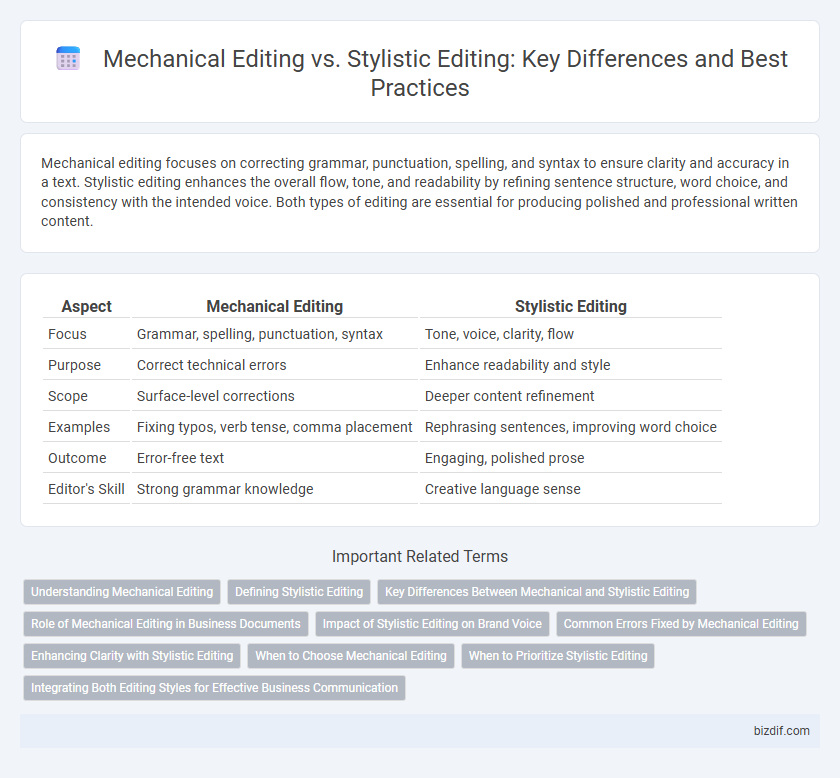Mechanical editing focuses on correcting grammar, punctuation, spelling, and syntax to ensure clarity and accuracy in a text. Stylistic editing enhances the overall flow, tone, and readability by refining sentence structure, word choice, and consistency with the intended voice. Both types of editing are essential for producing polished and professional written content.
Table of Comparison
| Aspect | Mechanical Editing | Stylistic Editing |
|---|---|---|
| Focus | Grammar, spelling, punctuation, syntax | Tone, voice, clarity, flow |
| Purpose | Correct technical errors | Enhance readability and style |
| Scope | Surface-level corrections | Deeper content refinement |
| Examples | Fixing typos, verb tense, comma placement | Rephrasing sentences, improving word choice |
| Outcome | Error-free text | Engaging, polished prose |
| Editor's Skill | Strong grammar knowledge | Creative language sense |
Understanding Mechanical Editing
Mechanical editing involves correcting grammar, punctuation, spelling, and syntax errors to ensure the text adheres to standard language conventions. It focuses on surface-level accuracy, making the writing clear and error-free without altering the content or style. This foundational editing stage enhances readability and prepares the manuscript for more in-depth stylistic or substantive revisions.
Defining Stylistic Editing
Stylistic editing focuses on enhancing the author's voice, tone, and readability by refining sentence structure, word choice, and flow. Unlike mechanical editing, which corrects grammar, punctuation, and spelling errors, stylistic editing aims to improve clarity and engagement while maintaining the writer's unique style. This process ensures the narrative remains compelling and tailored to the target audience.
Key Differences Between Mechanical and Stylistic Editing
Mechanical editing focuses on correcting grammar, punctuation, spelling, and syntax errors to ensure the text adheres to language rules. Stylistic editing enhances the overall flow, tone, clarity, and readability by refining word choice, sentence structure, and consistency in style. The key difference lies in mechanical editing addressing technical accuracy, while stylistic editing improves the narrative voice and engagement.
Role of Mechanical Editing in Business Documents
Mechanical editing ensures business documents maintain clarity and professionalism by focusing on grammar, punctuation, spelling, and formatting accuracy. This type of editing reduces errors that could undermine the document's credibility and impact, thereby enhancing effective communication with clients and stakeholders. Precise mechanical editing supports brand consistency and upholds the company's professional image in competitive markets.
Impact of Stylistic Editing on Brand Voice
Stylistic editing shapes a brand's voice by refining tone, rhythm, and word choice to resonate with the target audience, ensuring consistent messaging across all content platforms. Unlike mechanical editing, which focuses on grammar and punctuation accuracy, stylistic editing enhances emotional appeal and clarity, directly influencing brand perception and engagement. Consistent application of stylistic edits strengthens brand identity and fosters trust, making it a critical component in strategic content development.
Common Errors Fixed by Mechanical Editing
Mechanical editing addresses common errors such as punctuation mistakes, spelling inaccuracies, and grammatical inconsistencies to ensure clarity and correctness in a text. It corrects typographical errors, verb tense mismatches, subject-verb agreement, and improper use of articles and prepositions. This type of editing is essential for maintaining a polished and professional presentation before moving on to the nuanced improvements of stylistic editing.
Enhancing Clarity with Stylistic Editing
Stylistic editing enhances clarity by refining sentence structure, tone, and word choice to improve readability and flow. Mechanical editing focuses on correcting grammar, punctuation, and spelling errors without addressing the overall style or voice. Prioritizing stylistic editing ensures the message is conveyed effectively, creating a polished and engaging final draft.
When to Choose Mechanical Editing
Mechanical editing is essential when a manuscript contains frequent grammar, punctuation, and spelling errors that obscure the intended meaning. Choose mechanical editing early in the revision process to ensure clarity, consistency, and adherence to language conventions before addressing stylistic concerns. This type of editing is critical for academic papers, technical documents, or any text requiring precise language accuracy.
When to Prioritize Stylistic Editing
Prioritize stylistic editing when the goal is to enhance the tone, voice, and overall readability of the text, ensuring the author's unique style shines through. This type of editing is crucial for creative works, marketing materials, and narrative pieces where emotional impact and engagement are key. Mechanical editing, which focuses on grammar, punctuation, and syntax, should follow once the stylistic elements are polished to maintain clarity and correctness without compromising originality.
Integrating Both Editing Styles for Effective Business Communication
Mechanical editing ensures accuracy by focusing on grammar, punctuation, and spelling, which enhances the clarity and professionalism of business documents. Stylistic editing improves tone, readability, and consistency, aligning the content with the target audience and brand voice. Integrating both editing styles creates polished, error-free communication that effectively conveys messages and supports business objectives.
Mechanical Editing vs Stylistic Editing Infographic

 bizdif.com
bizdif.com